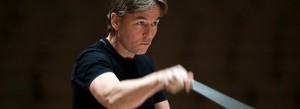The Los Angeles Philharmonic billed the Oct. 26 concert as a birthday tribute to “Hurricane Mama,” the iconic organ of Walt Disney Concert Hall. As a powerful storm must be handled with deft but equally powerful hands, the LA Phil called on the sorcerer from Finland, by way of London. Esa-Pekka Salonen, LA Phil’s conductor laureate, started the first of his concerts this season, delivering on his promise to spend more time in LA, after having served as the principal conductor of the Philharmonia Orchestra in London the past few years.
Salonen disturbed the otherwise quiet church Sunday by opening the program of sonic spectacle with 11 trumpets and two horns standing center stage in front of the pipes of the organ above the orchestra, heralding the opening fanfare from Leoš Janáček’s Sinfonietta. The optimism that is imbued throughout the piece is reflective of the liberation of the composer’s country, Czechoslovakia, from the Austro-Hungarian empire. There were other reasons to be happy. Janáček was finally receiving recognition as a composer. And love of country was accompanied by love of a beautiful woman; at the age of 63, he started a platonic love affair with a married actress 40 years younger. The sonic boom generated from the herds of LA Phil brass and orchestra, followed by the erupting audience, could have well created another bump in Frank Gehry’s roof.
Kaija Saariaho’s Maan varjot (Earth’s Shadows) is an intriguing exploration on the possibilities of pairing an organ with an orchestra. The organ has been traditionally reserved for climactic sections in orchestral settings. In 2007, the LA Phil presented Sofia Gubaidulina’s In Croce, which displayed the organ in a psychologically and emotionally menacing presence over the lone cello. Saariaho, however, takes a more fluid approach, where the organ may at one moment blend in with the brass or woodwinds, blend with the entire orchestra to augment its power, or separate to demonstrate its virtuosic flair.
Reflective of the line from Percy Shelley’s An Elegy on the Death of John Keats from which the composer got inspiration, “The One remains, the many change and pass,” the organ takes on many different sounds, both loud and soft, in foreground and background. But the organ’s presence is felt, regardless of the shape or form it takes.
The French organist Olivier Latry expressed deep admiration for Hurricane Mama, when he described the state of organ building during a pre-concert lecture as “before LA, and after LA.”
Salonen concluded the program with Jean Sibelius’ Lemminkäinen Legends, which has both the adventurous spirit of Janáček’s Sinfonietta and mystical sensation of Saariaho’s Maan varjot. The suite of four symphonic poems depicts the adventures of Lemminkäinen, a Finnish Don Juan, whose lustful appetite for young maidens leads him to trouble. In his pursuit of Pohjola’s daughter (the title of another one of Sibelius’ dramatic and colorful tone poems), Lemminkäinen takes up a series of challenges put forth by the sorceress Louhi, the daughter’s mother. While carrying out the last of his tasks to shoot the Swan of Tuonela with a single arrow, Lemminkäinen is killed by a blind herdsman, who then casts the mutilated corpse into the river. But in the end, Lemminkäinen’s mother comes to the rescue by patching up her son and bringing him back home in triumph.
Meeting a violent demise in the aftermath of pursuing a dream girl is one of the rites of passage that many of us go through as teenagers. Resurrection by our mothers after a heartbreak is not as relatable. However, Sibelius intended for Lemminkäinen to be atmospheric, unlike the tone poems by Franz Liszt and Richard Strauss that follow a particular narrative.
If atmosphere is what Sibelius wanted, then he could not have had a more fitting advocate than his fellow countryman Salonen. The turbulence from the hushed but rapid tremolos from the strings and the rumble of the barely audible bass drum in Lemminkäinen in Tuonela evoked a cool and mystical winter Finnish landscape. The rapid pecks of notes from the brass gave an eerie sense of a monster lurking in the forest.
Salonen’s sorcery is most evident in the opening of Swan of Tuonela, where Sibelius creates a mysterious aural texture with the muted lower strings that evoke a dark misty lake. The muted middle and upper strings then enter seamlessly with the same note, but at succeeding octaves, which reach higher and higher, giving the listener the impression of a foggy cloud clearing up to reveal the beautiful and vulnerable Swan.
LA Phil’s new Principal Cellist Robert deMaine has not only lived up to the esteemed reputation of his predecessors with his dark, brooding solo moments, but has added much flair to the already highly charged string section. In duos with the flamboyant principal violist, Carrie Dennis, deMaine and Dennis played with the intensity of a solar flare, with Dennis seamlessly concluding deMaine’s musical thought like the tail end of a flame.
This isn’t to say LA’s adopted sorcerer from Finland can’t whip up an exciting Tchaikovsky-esque end with his baton. The typically refined and cosmopolitan folks of the LA Phil had no trouble attacking the syncopated rhythms of the folksy themes in the triumphant Lemminkäinen’s Return. Each phrase was played with such tension that it seemed like the themes were not so much handed off from one section to another, but slingshotted over to the other side of the orchestra, bringing an exhilarating end to Lemminkäinen’s adventures.
Perhaps performing the Lemminkäinen Legends with the LA Phil is Salonen’s tacit admission that, despite his promiscuous relationships with world-class orchestras all over the world, the LA Phil remains his true love and home.
—Samuel Jang, Culture Spot LA
For information on upcoming concerts, visit www.laphil.com.






